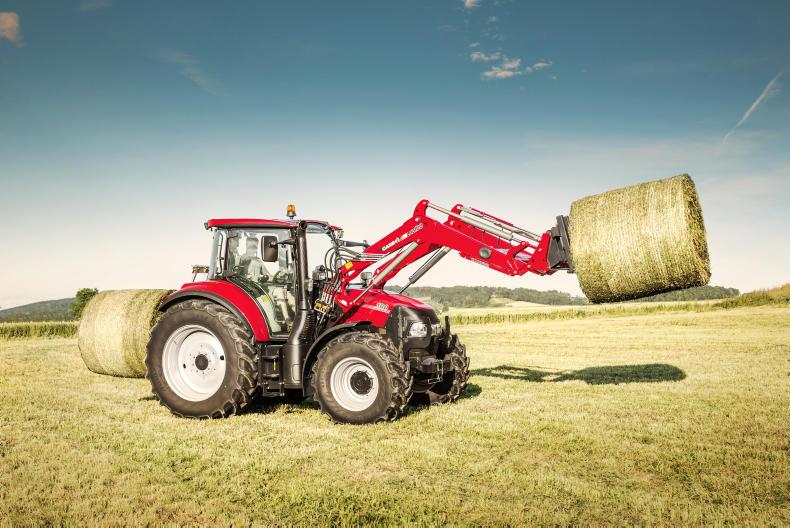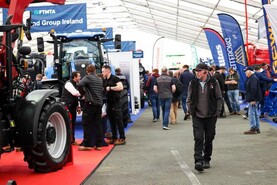The Case IH Luxxum tractor is aimed at the mixed farmer who wants a bit more tractor, and spends a bit of time in the seat. New controls, updated engines and a wide frame loader and cab are just some of the updates.
Controls
Taking inspiration from its larger tractors, the new multi-controller armrest control replaces the old gear lever which was used to shift between ranges. Integrated into the armrest is a new fixed lever to take control of most of the tractors functions such as transmission, hydraulics, engine and linkage. Adjacent to this is a new electric joystick control lever which can be used to operate a loader, the front hydraulic services or the rear services. Also included in the joystick are buttons for changing powershifts and de-clutching. As an option, a mechanical joystick to operate the loader can be specified, as can Case IH’s AFS 300 terminal, which is IsoBus class two-compliant and can be used for section control, for example. However, the tractor cannot be specified with integrated, automatic steering.
Transmission
The tractor uses a 32x32 transmission comprising two main, high and low ranges, changed by a mechanical lever, incorporated into which are four more ranges with four powershifts in each.
Developments to the transmission now include two automatic modes – field and road. Field mode allows the powershifts to change automatically within the range, while road mode (only available in the main high range) also includes automatic changing of the four ranges. From the dash, you can also limit which gears are automatically shifted through, and you can programme a start up gear for the road mode. A split throttle allows you to alter the transmission characteristics, ie when it automatically changes gear, from short shifting to save fuel, through to full power mode. For economy, the transmission can achieve 40kph at 1,750rpm. Shuttle aggression can now also be altered in three settings; soft, medium and hard,
There is a new, optional front axle suspension system at the front – the same system which is used on the larger Maxxum tractors. It too has been improved which now gets an extra accumulator for a smoother ride and increased traction. Suspension softness can be altered in three settings and it can be manually controlled to raise and lower the nose of the tractor, which is useful if trying to line up when attaching a loader, for example. Above 12kph, the suspension system is automatically activated and its new-found beefiness means the tractor’s total permissible weight increases to eight tonnes.
Hydraulic options include 80l/min or 100l/min closed circuit load-sensing pumps. With the 80l/min versions, mechanical-only hydraulic controls are fitted, while 100l/min models can be specified with mechanical or electrical. Loader-wise, the Luxxum can now accommodate an 80cm wider loader frame for improved stability and visibility, says Case IH.
Fitting in with the Luxxum’s proportions is a new Stage 4 compliant engine from sister manufacturer, FPT. The four-cylinder, 3.4-litre unit uses a combination of selective catalytic reduction and cooled exhaust gas recirculation to clean up emissions. However, FPT says, unlike its competitors which typically recirculate between 15% and 20% exhaust gases back through the engine, this engine only recirculates a maximum of 10%. Case IH says this will reduce the effort needed to cool the cool the engine. Instead of two valves per cylinder, four are now used, and the pressure in the engine’s common rail injection system has also been increased to 1,800 bar, for improved combustion, says Case IH. For prompt reaction to changing loads, a waste gate turbocharger is employed. Maximum torque is also up by 7% – 490Nm is now available at 1,500rpm on the 120 model, and maximum power is available from 1,900rpm. Engine oil changes are up to 600-hour service intervals.
As well as now meeting Stage 4 emissions regulations using FPT’s Hi-eSCR system with AdBlue and a diesel oxidation catalyst, the Case IH Maxxum also gets a change in wheelbase, a new roof design, an updated headland management system and a boost to class three IsoBus compatibility.
Five models from 116hp to 145hp (145hp to 175hp boosted) make up the range; four four-cylinder machines and now only one six-potter, which represents the top-of-the-range 150 model. While power levels for the range could easily be achieved using four-cylinder engines, a six-cylinder has been retained for its low-down torque characteristics.
In addition, all wheelbases are the same, regardless of using four- or six-cylinder engines. And to match the six-cylinder model’s length, the four cylinder variants have been fitted with a 26cm spacer between the engine and transmission. Benefits, according to Case IH, include better stability, balance and traction. And even though the four-cylinder tractors are now longer than their predecessors, the same turning circle is still maintained. Each model is available in one of three spec levels; Maxxum which features mechanical spool control and a simplified armrest, Maxxum multi-controller with integrated armrest controls, and Maxxum CVX with a continuously variable transmission (not available on the 150, six-cylinder model). As mentioned with the Luxxum, updated front suspension offers improved comfort and traction, while cab updates include a new roof design, which can incorporate up to 16 LED work lights and a new, one-piece windscreen. Its new HMC II headland management system allows sequences to be either pre-programmed or recorded, which can be later edited.
Finally, all Maxxums now come guidance-ready, with class three IsoBus certification. This means an implement can communicate with the tractor what to do, in terms of forward speed when baling or spraying, for example.
Read more
Special focus: FTMTA Farm Machinery Show
The Case IH Luxxum tractor is aimed at the mixed farmer who wants a bit more tractor, and spends a bit of time in the seat. New controls, updated engines and a wide frame loader and cab are just some of the updates.
Controls
Taking inspiration from its larger tractors, the new multi-controller armrest control replaces the old gear lever which was used to shift between ranges. Integrated into the armrest is a new fixed lever to take control of most of the tractors functions such as transmission, hydraulics, engine and linkage. Adjacent to this is a new electric joystick control lever which can be used to operate a loader, the front hydraulic services or the rear services. Also included in the joystick are buttons for changing powershifts and de-clutching. As an option, a mechanical joystick to operate the loader can be specified, as can Case IH’s AFS 300 terminal, which is IsoBus class two-compliant and can be used for section control, for example. However, the tractor cannot be specified with integrated, automatic steering.
Transmission
The tractor uses a 32x32 transmission comprising two main, high and low ranges, changed by a mechanical lever, incorporated into which are four more ranges with four powershifts in each.
Developments to the transmission now include two automatic modes – field and road. Field mode allows the powershifts to change automatically within the range, while road mode (only available in the main high range) also includes automatic changing of the four ranges. From the dash, you can also limit which gears are automatically shifted through, and you can programme a start up gear for the road mode. A split throttle allows you to alter the transmission characteristics, ie when it automatically changes gear, from short shifting to save fuel, through to full power mode. For economy, the transmission can achieve 40kph at 1,750rpm. Shuttle aggression can now also be altered in three settings; soft, medium and hard,
There is a new, optional front axle suspension system at the front – the same system which is used on the larger Maxxum tractors. It too has been improved which now gets an extra accumulator for a smoother ride and increased traction. Suspension softness can be altered in three settings and it can be manually controlled to raise and lower the nose of the tractor, which is useful if trying to line up when attaching a loader, for example. Above 12kph, the suspension system is automatically activated and its new-found beefiness means the tractor’s total permissible weight increases to eight tonnes.
Hydraulic options include 80l/min or 100l/min closed circuit load-sensing pumps. With the 80l/min versions, mechanical-only hydraulic controls are fitted, while 100l/min models can be specified with mechanical or electrical. Loader-wise, the Luxxum can now accommodate an 80cm wider loader frame for improved stability and visibility, says Case IH.
Fitting in with the Luxxum’s proportions is a new Stage 4 compliant engine from sister manufacturer, FPT. The four-cylinder, 3.4-litre unit uses a combination of selective catalytic reduction and cooled exhaust gas recirculation to clean up emissions. However, FPT says, unlike its competitors which typically recirculate between 15% and 20% exhaust gases back through the engine, this engine only recirculates a maximum of 10%. Case IH says this will reduce the effort needed to cool the cool the engine. Instead of two valves per cylinder, four are now used, and the pressure in the engine’s common rail injection system has also been increased to 1,800 bar, for improved combustion, says Case IH. For prompt reaction to changing loads, a waste gate turbocharger is employed. Maximum torque is also up by 7% – 490Nm is now available at 1,500rpm on the 120 model, and maximum power is available from 1,900rpm. Engine oil changes are up to 600-hour service intervals.
As well as now meeting Stage 4 emissions regulations using FPT’s Hi-eSCR system with AdBlue and a diesel oxidation catalyst, the Case IH Maxxum also gets a change in wheelbase, a new roof design, an updated headland management system and a boost to class three IsoBus compatibility.
Five models from 116hp to 145hp (145hp to 175hp boosted) make up the range; four four-cylinder machines and now only one six-potter, which represents the top-of-the-range 150 model. While power levels for the range could easily be achieved using four-cylinder engines, a six-cylinder has been retained for its low-down torque characteristics.
In addition, all wheelbases are the same, regardless of using four- or six-cylinder engines. And to match the six-cylinder model’s length, the four cylinder variants have been fitted with a 26cm spacer between the engine and transmission. Benefits, according to Case IH, include better stability, balance and traction. And even though the four-cylinder tractors are now longer than their predecessors, the same turning circle is still maintained. Each model is available in one of three spec levels; Maxxum which features mechanical spool control and a simplified armrest, Maxxum multi-controller with integrated armrest controls, and Maxxum CVX with a continuously variable transmission (not available on the 150, six-cylinder model). As mentioned with the Luxxum, updated front suspension offers improved comfort and traction, while cab updates include a new roof design, which can incorporate up to 16 LED work lights and a new, one-piece windscreen. Its new HMC II headland management system allows sequences to be either pre-programmed or recorded, which can be later edited.
Finally, all Maxxums now come guidance-ready, with class three IsoBus certification. This means an implement can communicate with the tractor what to do, in terms of forward speed when baling or spraying, for example.
Read more
Special focus: FTMTA Farm Machinery Show






 This is a subscriber-only article
This is a subscriber-only article











SHARING OPTIONS: